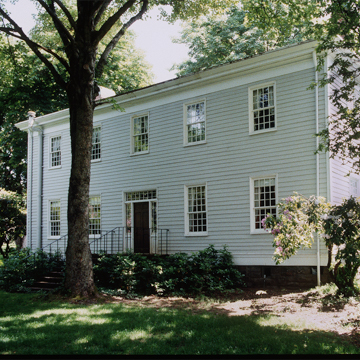You are here
Dr. John McLoughlin House
The Dr. John McLoughlin House, on the elevated bluff in Oregon City, is arguably the most important Federal house in Oregon, and maybe even in the Pacific Northwest. It is the surviving residence of a man often called the “father of Oregon,” who operated the Hudson’s Bay Fort Vancouver trading post for the British and who welcomed Oregon Trail overland trekkers and helped them settled in the Willamette Valley against the direct orders from his Hudson’s Bay Company superiors.
Dr. John McLoughlin was a giant of a man, standing 6 feet 4 inches with a great mane of pure white hair that prompted the Oregon native peoples to call him the “White-Headed Eagle.” Born in Quebec to Scottish and Irish immigrants, McLoughlin studied medicine and passed his medical examination (equivalent to modern licensing) before signing on with the Hudson’s Bay Company (typically shortened to “The Bay”). He was stationed at various central Canadian company trading posts, and rose in The Bay organization to a position of significant responsibility, eventually being sent overland to the Columbia River area in 1825 to establish and run the company’s central trading post on the Pacific coast. McLoughlin selected a site on the north bank of the Columbia with good access to the sea about 90 miles upriver from the Columbia’s mouth, at the juncture of the Willamette River, the major stream flowing from the south. Called Fort Vancouver, after the British naval explorer, this trading post became the center of Pacific Northwest fur trading activity and grew to become a small self-supporting village well-stocked with stores of trade items.
When American overland wagon trains began to enter the Oregon country in the 1840s, McLoughlin was explicitly instructed by the Hudson Bay Company to turn the bedraggled, starving travelers back, for fear that settlement in the area would reduce the population of fur-bearing animals. McLoughlin shifted his political allegiance, permanently settling in what was now Oregon City (which he officially platted in 1842 and redid in 1843) to run his various trading and business enterprises. The McLoughlin House was built in 1844–1845. It was a simple, hipped-roof rectangular box with a commodious central-hall, double-pile plan. Federal in style, it was likely modeled after the residence of Dr. Solomon Jones (1800–1801) in Maitland, Ontario, a house McLoughlin may well have visited, since he would never have seen such a house on the west coast of the United States. Like the Jones House, McLoughlin’s residence has a wide entry with a broad front door flanked by narrow side lights and a rectangular transom light. The house was built with lumber from McLoughlin’s mills, but windows and other trim were shipped from the eastern United States. Some of the rooms were used by McLoughlin as his business offices, and some of the small bedrooms may have been used by business visitors.
Built near the Willamette Falls, close to McLoughlin’s saw mills and other businesses (including a gristmill, granary, general store, and a shipping concern), the house faced the river. Following McLoughlin’s, and then his wife’s, death, the house was put to various uses, including, by the end of the century, a hotel and eventually a brothel, as the neighborhood changed with industrial expansion around the falls. When a paper company wished to demolish the house to expand its facility, a group of citizens familiar with McLoughlin’s important role in Oregon history endeavored to preserve the house. Since it could not remain on its original site, in 1909 it was lifted from its foundations, put it on wheeled carriages, and moved by horse up the inclined road, ascending the side of the bluff to an open area that McLoughlin himself originally set aside as a public park. The relocated house was placed on a new foundation, but with its original orientation relative to the river, meaning that the wide entry door is now at the back of the house while the narrower rear door opens directly on to the street.
In 1910, the year following its move, the house opened as a museum. The McLoughlin House was added to the National Park System in 2003, becoming part of the Fort Vancouver National Historic Site, which also includes the reconstructed Fort Vancouver on the Washington side of the Columbia. The house remains open to the public.
References
Barker, Burt Brown. The Dr. John McLoughlin Hose: A National Historic Site. Oregon City: McLaughlin Memorial Association, 1949.
Holman, Frederick Van Voorhies. Dr. John McLoughlin: the Father of Oregon. Cleveland: Arthur Clark Company, 1907.
Marquis, A .S. Dr. John McLoughlin (The Great White Eagle). Toronto, ON: Ryerson Press, 1929.
Montgomery, Richard Gill. The White-Headed Eagle, John McLoughlin, Builder of an Empire. New York: Macmillan, 1934.
Morrison, Dorothy N. Outpost: John McLoughlin and the Far Northwest. Portland: Oregon Historical Society, 2005.
Smelser, June. “A History of the McLoughlin House.” Clackamas County Historical Society(1960): 27-55.
Writing Credits
If SAH Archipedia has been useful to you, please consider supporting it.
SAH Archipedia tells the story of the United States through its buildings, landscapes, and cities. This freely available resource empowers the public with authoritative knowledge that deepens their understanding and appreciation of the built environment. But the Society of Architectural Historians, which created SAH Archipedia with University of Virginia Press, needs your support to maintain the high-caliber research, writing, photography, cartography, editing, design, and programming that make SAH Archipedia a trusted online resource available to all who value the history of place, heritage tourism, and learning.




















